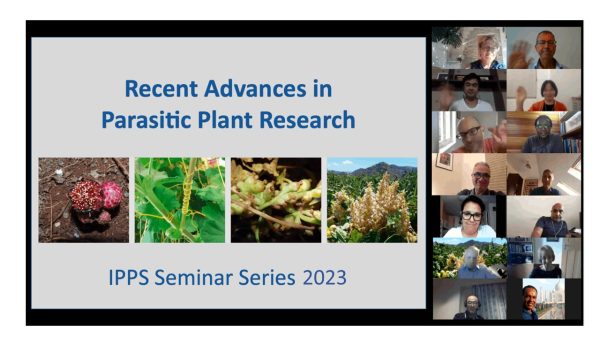Hanan Eizenberg and Ahmet Uludag
The 2nd 2023 monthly IPPS seminar will be held Wednesday 3 May at 4:00 pm central European time. You can use this website for time zone conversion. The next seminars will take place on 7 June and 5 July, combined with the IPPS General Assembly.
On 3 May we will have the following talks:
Hanan Eizenberg – Predicting the dynamics of broomrape parasitism as a basis for decision support systems to control the parasite. What have we learned after twenty years of research?
and
Ahmet ULUDAĞ – Broomrape control ın tomato growıng: one method is not enough
IPPS members can join the seminar by a Zoom link provided in the members area of the IPPS website.
Not a member yet, but want to join the seminar? You can register here for an IPPS membership!
4:00 PM cet = 7:00 AM Los Angeles, 9:00 AM Bogota, 10:00 AM New York/Santiago, 11:00 PM Brasilia, 4:00 PM Abuja/London, 4:00 PM Amsterdam/Berlin/Cape Town, 5:00 PM Tel Aviv/Nairobi, 10:00 PM Beijing, (next day) 11:00 PM Tokyo, 0:00 AM Canberra (next day).
Over the past 25 years, Prof. Hanan Eizenberg has studied the biology of root parasitic weeds, the broomrapes, and explored possible management methods. Prof. Eizenberg and his group have led research on modeling broomrape development, for its precise control and facilitating remote sensing for early broomrape detection. He pioneered the development of decision support systems (DSS) based on models for predicting parasitism dynamics below the soil surface. These models were then tested and validated over 20 years under field conditions. Prof. Eizenberg supervised 20 graduate students and post-doctoral fellows and published with his group more than 40 research papers in the field of parasitic plants.
Abstract
Root parasites (Phelipanche and Orobanche spp.) are serious pests in Israeli agriculture. Species of economic importance include Egyptian broomrape (P. aegyptiaca), crenate broomrape (O. crenata), and sunflower broomrape (O. cumana). Crops affected by broomrape include mostly plants from the botanical families of Solanaceae, Fabaceae, Asteraceae, and Umbellifers. The damage caused by the aforementioned broomrape species in field and vegetable crops can be highly severe and may result in total yield loss. Current broomrape control protocols are exclusively targeted at the specific host-parasite interaction.
Chemical-based solutions (herbicides) may be suitable for different broomrape species parasitizing the same host, however, they are not always efficient for hosts from other botanical families. There are several reasons for this: a) as reported in many papers, the interactions between the parasite and the host are different in terms of the dynamics of parasitism; b) selectivity of the hosts to different herbicidal modes of action; c) different herbicides application methods. The major challenge in developing principles for smart broomrape management is based on the fact that most of the parasitic plant life cycle occurs below the soil surface, resulting in great difficulty to determine the optimum timing for herbicide applications. Other issues that may prevent successful management are; the spatial variations in seed infestation within plots, the duration of herbicide action and depth in the soil, the timing of subsequent applications, and the most appropriate dosage for each stage of parasite infection. Therefore, the basis for smart broomrape management is the study of the temporal and spatial dynamics of the parasite in the agricultural field, and the correct and precise herbicide application using the most effective application systems available at each farm. Over twenty years of research, we have developed several decision support systems based on these principles for the control of Egyptian broomrape in tomatoes, carrots, and cabbage and also for the management of sunflower broomrape in sunflower.
These decision support systems allow growers to cultivate crops such as tomatoes, carrots, cabbage, and sunflower in fields infested with broomrape with minimal damage. In my talk, I will describe different models for predicting host-parasite dynamics based on soil temperature measurements, I will discuss approaches for studying the spatial variation of broomrape in the field and the means for precise application of herbicides. In addition, I will discuss various obstacles encountered by farmers in the field using these models and how research is addressing issues of herbicide-induced damage, herbicide degradation in soil, and the role of the microbiome in broomrape control with herbicides.
Prof. Ahmet ULUDAĞ has worked as weed science researcher, quarantine inspector, and weed science professor as well as invasive alien species specialist. In his career, he has dealt with parasitic plants. Currently, he works on broomrape control in tomato among other weed science projects
Abstract
Tomato has worldwide importance from nutritional value to economical value. Broomrapes (Orobanche and Phelipanche spp.) are among foremost problems in tomato growing. Five out of seven important crop parasitizing broomrapes have been recorded on tomato, namely P. ramosa, P. aegytptiaca, O. cernua, O. cumana and O.crenata. The motto of broomrape control has been “one method is not enough”. In this presentation, methods to control broomrape will be reviewed although there have been several high-quality reviews published. Knowledge on the implementation of measures and our experiences will be blended to convey our view to colleagues.
